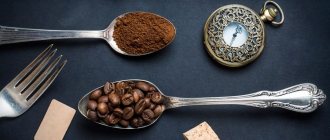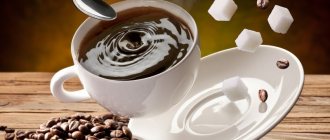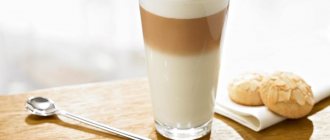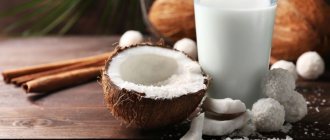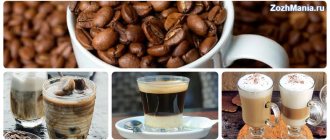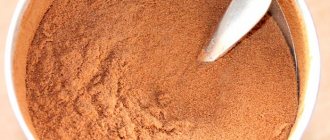Instant coffee is a low-calorie product that can give you strength and energize you. Attempts to produce this drink were made in the 18th century. in Britain by order of the War Office. By the beginning of the 20th century. Belgian chemist J. Washington, interested in the remnants of coffee plaque on the walls of the Turk, developed a technology for creating an instant drink.
By 1909, under his management, mass production of the Red E Coffee brand began.
What kind of coffee is there? Kinds
On July 24, 1938, conveyor production of the drink by Nestle began in Switzerland. The J. Washington company ceased to exist in 1961. Instant coffee, the calorie content of which varies from 2 to 270 kcal per 100 g, is made from a dry concentrate extracted from natural beans, sometimes robusta.
Each manufacturer has unique production methods to preserve aroma and flavor properties. Instant coffee, according to statistics, is one of the best-selling products.
The ranking of countries consuming the largest amount of instant coffee compared to natural coffee includes:
- Australia – 75%;
- Russia – 70-80%;
- Eastern Europe – 50%;
- Middle Eastern countries – 40%.
To produce instant drinks, the following are usually used:
- exclusively robusta;
- a mixture of robusta and arabica;
- exclusively Arabica.
Unscrupulous manufacturers include ground chicory, chestnut, and wheat grains in the composition.
Each of the 3 types of instant coffee on the market (powdered, granulated and freeze-dried) has its own production technology:
- evaporation method (spray dry);
- vacuum drying with pre-freezing (freeze dry).
In the first case, a highly concentrated drink is sprayed under the influence of a stream of hot air. After the moisture evaporates, coffee powder is formed. With additional steam processing of the powder, granulated coffee is obtained by combining small particles. Due to the additional production step (humidification), granulated coffee is more expensive than powdered coffee.
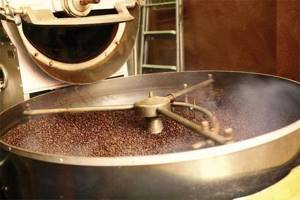
The freeze-dry method consists of the following main steps:
- cooling the coffee extract to -6⁰;
- subsequent application of the raw material in a thin layer on a steel drum or belt and freezing to -40⁰;
- grinding, sifting formed slabs of ice;
- separating coffee granules from liquid.
This method is used to produce an expensive and higher quality type - sublimated. Due to the absence of heat treatment, the method allows you to maximally preserve the taste, aroma and beneficial properties of natural grains.
The freeze-dried variety contains mostly a high percentage of caffeine, which is an indicator of good quality. Freeze-dried coffee granules are smooth and shiny. Whatever the production method, processed coffee does not fully convey the rich and vibrant aroma of the beans.
Each manufacturer has its own secrets for flavoring dry drinks. For more expensive types, in particular freeze-dried, the essential oils of the grains are collected using a special technology and added to the dry product. For low-cost types, artificial flavors are used.
Sometimes you can find decaffeinated instant coffee on sale. During the production process, coffee extract is passed through carbon filters. This method allows you to retain caffeine molecules. Due to additional costs, the price of this drink is higher.
Calorie content of black coffee
In chemical terms, coffee is an aqueous solution of organic compounds extracted from coffee beans. Coffee grounds contain proteins, fats and carbohydrates. Even a specialist will not say how much of these substances will dissolve in hot water when brewed and, accordingly, what the calorie content of coffee will be.
Espresso is considered the standard of black coffee. Its energy value depends on the type of coffee, extraction time, and water temperature. It is not surprising that in different sources there are figures ranging from 2 to 9 kcal per 100 ml of espresso. The calorie content of the drink is so low that it is easiest to take the largest number as a basis. If we assume that 100 ml of espresso contains 9 kcal, then one serving (25 ml) contains about 2.25 kcal. To carry out more accurate calculations, too complex equipment would be needed.
A shot of espresso is black coffee brewed from 7 g of coffee beans and 25–28 ml of water. If you pour the same amount of ground coffee with a large amount of water, the calorie content of the drink will not increase, since water has no nutritional energy value. Therefore, the calorie content of an arbitrarily large serving of Americano made from one shot of espresso does not exceed 2.25 kcal.
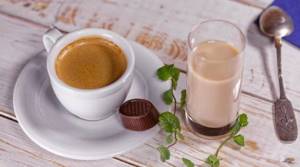
The calorie content of a cup of coffee depends on the sugar, milk, cream and alcohol in the composition.
Using the same principle, you can calculate the calorie content of lungo. To prepare it, use 7 g of coarsely ground natural coffee powder (sometimes the extraction time is increased). Although a lungo is twice the size of an espresso, the calories are approximately the same.
The energy value of a serving of ristretto can only be approximately calculated. The drink is prepared from the same 7 g of ground beans as espresso, the extraction process is simply interrupted earlier, so the serving volume is 15 ml. It would not be a mistake to assume that the calorie content of ristretto does not exceed the calorie content of espresso: the same amount of coffee beans is used to prepare both drinks. Therefore, the calorie content of a serving of ristretto is 2.25 kcal.
Using the same principle, you can calculate the calorie content of coffee brewed in a Turk, French press, pour over, or geyser coffee maker. The value of the indicator depends not on the volume of water, but on the number of ground grains.
If you pour 100 ml of water into 6–7 g of ground beans to prepare a drink, the calorie content of coffee will be 1.92–2.25 kcal. With the classic proportion for Turkish or pourover 1:10 (10 g of ground grains per 100 ml of water) – 3.21 kcal.
Calorie content of 100 g of dry instant coffee is 119 kcal. A teaspoon contains about 6 g of powder, 100 g - 17 teaspoons. The calorie content of a teaspoon of instant coffee is 7 kcal. This amount of powder is enough to prepare 100 ml of drink.
Energy value
Natural coffee beans have a unique composition. There is still no method capable of conveying all the benefits, aroma and taste of grain.
Instant coffee, the calorie content of which varies from manufacturer to manufacturer, contains on average:
- freeze-dried – from 90 to 140 kcal per 100 g of dry product;
- granulated - on average 38 kcal/100 g;
- powder – from 2 to 9 kcal/100 g.
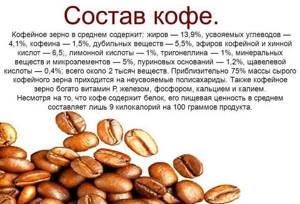
Composition and calorie content of instant coffee
The amount of proteins, fats and carbohydrates also differs. The table shows examples of analysis of calorie content and nutritional supplements of some well-known brands in 100 g of dry product.
| Name | Calorie content, kcal | Proteins, g | Fats, g | Carbohydrates, g | 1 tsp. (2.5 g), kcal |
| Carte Noire Classic | 100 | 14 | 0.04 | 10.3 | 2.5 |
| Egoiste | 99 | 1.14 | 3.6 | 1.9 | 2.4 |
| Jacobs Monarch | 102 | 14.5 | 0.45 | 10 | 2.55 |
| Nescafe Gold (powder) | 2 | 0.2 | 0 | 0.36 | 0.04 |
| Davidoff | 180 | 17.12 | 3.6 | 19.7 | 4.5 |
| Tchibo Exclusive | 170 | 15.3 | 5.6 | 1.4 | 2.25 |
The calorie content of the finished drink based on instant coffee is increased by additives such as:
- sugar: 1 tsp. (8 g) – 32 kcal;
- milk: 20 ml (1 tbsp.) 1.5% fat content – 9 kcal, 2.5% fat content – 11 kcal, 3.2% fat content – 12 kcal;
- condensed milk: 30 g (1 tbsp.) – 95 kcal;
- cognac: 30 g – 72 kcal;
- liqueur: per 30 g from 60 to 100 kcal;
- syrup: 30 g – 60-80 kcal.
The dry drink may contain up to 10% ash and up to 4.2% caffeine.
How many calories are in instant coffee?
On the packaging of any modern product purchased in a store, you can find very useful information about the calorie content of 100 grams of purchase. Manufacturers do not hide from us how many calories are in instant coffee. Depending on the variety and type, this figure ranges from 90 to 100 kilocalories. A lot of? Still would! But please note that the data refers to 100 grams of dry product. We use much less per cup. Therefore, the calorie content of the coffee solution will be much lower. Let's do some math.
We usually add 1.5-2 tablespoons of instant coffee to 200 grams of water. Many limit themselves to even less. A heaped teaspoon holds about 6 grams of dry product, which contains 5.5 to 6 kilocalories. Did you put two spoons? We received a drink with approximately 11-12 kilocalories.
To calculate the calorie content of instant coffee or any other water infusion, you need to divide the number of kilocalories indicated on the package by 100, and then multiply by the number of grams of the product that you took for preparation. The resulting figure will be the general indicator of your drink, because water has no calorie content.
Beneficial features
Instant coffee made from natural high-quality raw materials contains a certain amount of vitamins and oils.
In addition to caffeine, small amounts may include:
- phosphorus;
- iron;
- sodium;
- calcium;
- antioxidants;
- vitamins B2 and PP.
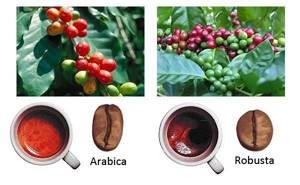
When consumed in moderation, the drink can benefit the body. The caffeine concentration is different for each manufacturer: in 1 cup (250 ml) – 30-200 mg. This substance has a diuretic and invigorating effect, increases concentration.
Also, an instant drink can:
- activate enhanced brain function;
- prevent the risk of developing depression;
- improve mood due to an increase in the blood level of serotonin, the hormone of happiness;
- speed up digestion by increasing the acidity of the body;
- increase blood pressure, which is an advantage for people suffering from low blood pressure.
Depending on your health condition, the recommended intake of instant coffee is 1-2 cups per day. This amount contains the acceptable daily dose of caffeine.
How many calories are in a coffee spoon?
1 coffee spoon (heaped) = 2.38 kcal
1 coffee spoon (without slide) = 1.19 kcal
* 100 grams of instant coffee = 119 calories
Calorie content of supplements
- 1 teaspoon of sugar will increase the calorie content of coffee by 24 kcal
- 10 g cream – for 20-60 kcal (depending on fat content)
- 2 tbsp. spoons of milk 2.6% – 21 kcal
- 1 teaspoon of condensed milk – 35 kcal
- 1 teaspoon of chocolate syrup – 15 kcal
- A scoop of ice cream weighing 50 g – 113.5 kcal

Calorie content of a teaspoon of coffee (question, answer)
- How many calories are in 1 teaspoon of coffee (without a slide)? = 2.38 calories
- How many calories are there in one heaping teaspoon of coffee? = 3.57 calories
- 2 teaspoons of coffee (without slide) how many calories? = 4.76 calories
- How many calories are in two heaping teaspoons of coffee? = 7.14 calories
- 3 teaspoons of coffee (without slide) how many calories? = 7.14 calories
- How many calories are in three heaping teaspoons of coffee? = 10.71 calories
Calorie content of a tablespoon of coffee (question, answer)
- How many calories are in 1 tablespoon of coffee (without a slide)? = 7.14 calories
- How many calories are in one heaping tablespoon of coffee? = 10.71 calories
- 2 tablespoons of coffee (without slide) how many calories? = 14.28 calories
- How many calories are there in two heaping tablespoons of coffee? = 21.42 calories
- 3 tablespoons of coffee (without slide) how many calories? = 21.42 calories
- How many calories are in three heaping tablespoons of coffee? = 32.13 calories
Contraindications and harm
Poor quality coffee may contain additives that can harm the body:
- preservatives;
- stabilizers;
- dyes;
- carbonic acid;
- artificial flavors.
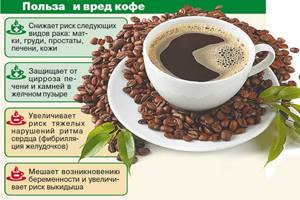
Abuse of the drink can lead to adverse consequences:
- Caffeine destroys the nervous system, leading to its depletion. In this regard, an instant drink will do much more harm, since the caffeine of natural beans is eliminated from the body after 3 hours, while that of a soluble drink is eliminated after 10 hours.
- Caffeine abuse is addictive. Without the next portion of the drink, the body will not be able to function fully. A person who has been drinking more than 2-3 cups of coffee a day for a long time, trying to eliminate the drink from the diet, experiences a loss of strength, a decrease in reaction speed, and headaches may occur.
- The diuretic property of coffee leads to dehydration. The drink removes important vitamins from the body (in particular, vitamins A, group B, PP) and minerals (such as calcium, potassium, iron). With prolonged coffee abuse, the skin becomes dull, prone to premature aging, and loses elasticity.
- Regular consumption of instant drinks in large quantities is one of the reasons for the development of cellulite. Caffeine provokes the production of adrenaline. Due to drinking the drink in excess of the norm, the body does not have time to process large volumes of adrenaline, which increases the risk of deposits appearing in problem areas. Instant coffee is characterized by a high level of pesticides, which lead to digestive disorders and provoke the formation of fatty deposits.
- During the production of instant coffee, as a result of prolonged heating, the carcinogen acrylamide is released, which, when entering the body in large quantities, according to scientists, causes the formation of kidney stones.
- An increase in acidity levels negatively affects the functioning of the gastrointestinal tract.
Doctors do not recommend drinking this drink for people suffering from:
- heart defects;
- hypertension;
- obesity;
- chronic diseases of the gastrointestinal tract, pancreas and gall bladder;
- pathologies of the genitourinary system.
Instant coffee is prohibited for use during pregnancy and for children under 14 years of age.
Calorie content of instant coffee with sugar
We all know that coffee perfectly invigorates, gives energy and strength, and also has a unique special taste and aroma, which is why many people fall in love with this wonderful drink for life. Coffee has a long history, with many varieties and recipes dating back to antiquity.
The answer to such an important question about the calorie content of instant coffee will please everyone, including girls who care about their figure. So, instant coffee contains only 2 calories. But keep in mind that this only applies to the coffee itself, without additives. Thus, instant coffee with sugar contains 50 Kcal.
It is difficult to calculate how many kilocalories are in one cup of coffee, since the number will always vary depending on the volume of a particular cup, and therefore the data above shows the number of calories per 100 g of dissolved coffee drink.
A little mathematics and the indicator is obtained. For example, calculation of instant coffee: multiply 5 kilocalories per glass of 250 mg, it turns out 7.5 kilocalories.
Rating
When choosing a drink that is suitable for its aroma and taste, you should pay attention to the following quality indicators:
- information about the country of origin indicated on the label must correspond to the barcode information;
- 100% Arabica coffee contains less caffeine than Robusta coffee;
- Sublimated coffee is considered the most similar in aroma and taste to natural coffee;
- bread notes in the aroma indicate the addition of roasted barley;
- if the coffee smells like burnt cork, this indicates a violation of the production technology or the presence of over-roasted beans;
- granules must have a dense consistency, not stick together and completely dissolve in water, without the formation of suspensions and impurities;
- the composition must contain no foreign ingredients;
- If the color of the granules is too dark, it may indicate that the coffee is burnt.
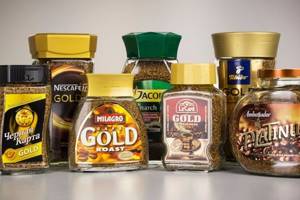
Instant coffee, the calorie content of which in a freeze-dried drink reaches 270 kcal per 100 g, has its own characteristic taste and aroma, depending on the manufacturer. The table provides information about some of the most popular instant coffee brands.
| Name | Peculiarities | average cost |
| Carte Noire Classic |
| from 350 rub. for 95 g |
| Bushido |
| from 434 rub./50 g |
| Egoiste |
| from 340 rub./100 g |
| Davidoff |
| 259 rub. 70 g |
| Moccona |
| on average 214 rubles. for 95 g |
| Moscow coffee shop on shares |
| 219 rub. 75 g |
| Bourbon |
| from 319 rub. 100 g |
| Tchibo |
| from 200 rub. for 95 g |
| Ambassador |
| 200 rub. 95 g |
| Jacobs Monarch |
| 250 rub. 95 |
| Nescafe Gold |
| 220 rub. 95 g |
The advantages of instant coffee include low calorie content, ease of preparation, and affordable cost. Some coffee lovers prefer a softer instant drink to the strong and rich taste of natural beans. In all cases, it is important to follow the consumption rate so as not to harm the body.
How many calories are in coffee with sugar?
There is no definite answer to this question and there cannot be. Everything varies depending on the volume of the cup, the amount of dry matter, and especially the sweetener, as well as the method of preparation. But you can roughly calculate the number depending on how much and what kind of sugar you add, since the calorie content of the finished drink will depend entirely on the amount of sugar. At the same time, we assume that there are no more additives in the coffee.
Loose sugar
One standard size teaspoon holds:
- 5 g without slide;
- 7 g with a small slide;
- 10 g with a large slide.
When they talk about a spoonful of sugar, they usually mean a small heaped teaspoon, that is, 7 grams.
Calorie table for different types of sugar
| Type of sugar | Kcal per 100 g | kcal, per 5 g | kcal, per 7 g | kcal, per 10 g |
| Sand | 390 | 19,5 | 27,3 | 39 |
| Raw, crystals | 360 | 18 | 25,2 | 36 |
| Reed | 400 | 20 | 28 | 40 |
| Maple | 350 | 17,5 | 24,5 | 35 |
Refined sugar
Refined sugar is not standardized in any way in terms of the weight of the cubes. Depending on the shape of the abs, one cube can weigh from 3.4 to 5.95 grams.
Caloric content of refined sugar – 400 kcal per 100 grams. To calculate the exact weight of one cube, you need to open the package, count how many cubes are in one layer, multiply by the number of layers. We get the total number of cubes in the package. Divide the total weight by the quantity, we get the exact answer. Sometimes manufacturers write this data on the packaging, but this is rare.
- On average, small cubes weigh 4.5 g;
- Large cubes of “standard” size – 5.5 g.
Based on the energy value and total calorie content per 100 g of product, we find that 1 gram of refined sugar contains 4 kcal.
| Cube weight | One cube, kcal | Two cubes, kcal | 3 cubes, kcal |
| Cubes 4.5 g | 18 | 36 | 54 |
| Cubes 5.5 g | 22 | 44 | 66 |
Sugar in sticks
Usually available in standard 5 gram sticks. There are exceptions in the form of large sachets of 10 g and small sticks of 4 grams. Ordinary granulated sugar with a nutritional value of 390 kcal per 100 grams is placed there, that is:
| Packing | 1 piece, kcal | 2 pcs, kcal | 3 pcs, kcal |
| Stick 4 g | 15,6 | 31,5 | 46,8 |
| Stick 5 g | 19,5 | 39 | 58,5 |
| Stick 10 g | 39 | 78 | 117 |



